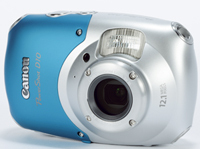
Water is one of the essential elements of life, and as it turns out, it?s also one of the building blocks for great photographs. There are countless ways in which you can use H20 as a compositional element to add colour, drama or motion to your pictures.

At this point we would like to remind you that you must include your address and details of your image in your email entry so we can judge your photograph accurately. Without a sentence explaining what your image depicts, our judges have to guess ? and they may guess wrong! And without your address and other contact details we cannot reach you in the event that you make the shortlist or win the round. See APOY 2009.
As spring moves in summer, it?s a dead cert that water will figure into your plans. Either the weather will be pleasant and we?ll all head for the nearest beach, or it will be a washout like the past couple of years. Whatever summer brings, it?s another certainty that water holds enormous potential for making stunning images in a range of styles.
One obvious option is the sea. For thousands of years, artists have been rediscovering its beauty, and it provides endless options for great pictures. The rhythmic motions of the tide offer great potential for capturing movement, while the coastline itself can be used as a leading line to guide your eye to other interesting features. Likewise, the stillness of a tranquil lake presents the opportunity to capture reflections, as do the tiny drops of dew on your grass in the morning. Look at the features and functions of water. See how you can use them to your advantage, whether it?s the reflective properties of water, its ability to freeze or something else entirely. We?ve provided some tips and techniques below to help get you started. With such a wide range of possibilities at your disposal, we hope to see a full and diverse group of images this month. Judging by what we?ve seen in the rounds so far, we?re sure we will.
Foreground 
Because bodies of water are generally flat, images have a tendency to look shapeless and have no sense of scale. Framing something of interest in the foreground is a great way to overcome this obstacle. A subject in the foreground gives depth to your image, and when you include another object in the background you can give the viewer a sense of scale.
 Get close
Get close
You don?t have to live by the sea to photograph an ocean. With the right lens you can make a single drop of water look like the Atlantic, or better still, you can use its reflective properties to create a nice abstract image. A drop of water reflects an area of about 120° behind it. Use this to your advantage. Try placing a few drops in front of some interesting backgrounds (which only need to be a few inches wide) and see what you can capture. photograph by Adam Stilwell
Motion 
There are different ways of portraying moving water, each providing a different effect. A long exposure produces a brighter, softer result, while a fast shutter speed will stop the motion and give you dramatic frozen action. Former APOY winner Paul Whiting wrote a guide to photographing moving water in AP 16 May 2009. He included tips such as using the water?s motion to create leading lines and fitting an ND filter to reduce light levels when longer shutter speeds are required but the ISO is set to its lowest value. photograph by Chris Davies
1st prize 
Our first-place winner will receive Canon?s brand new 15.1MP EOS 500D, worth £869.99. The lucky winner will benefit from continuous shooting at up to 3.4fps with up to 170 JPEG burst, as well as nine-point AF and a high ISO going up to 12,800, making it ideal for low-light conditions. The EOS 500D boasts a 3in Clear View LCD with Live View mode and the ability to record High Definition videos. The winner will also receive Canon?s compact, lightweight EF-S 18-55mm f/3.5-5.6 lens, worth £209.99. Ideal for shooting outdoors, this lens offers a very close focusing distance and a fast AF speed.
2nd prize 
Our second-place winner will receive Canon?s PowerShot D10 compact camera, worth £369. Boasting 12.1MP, the rugged D10 is resistant to water, shock, dust and cold, making it perfect for your summer holidays. With a 3.0x zoom and optical IS, and scene, face and motion-detection technology, the D10 covers all your photographic needs. The second-place winner will also receive the D10 Accessory Kit, worth £109, which contains a front cover set, shoulder and neck straps, a carabiner strap and a soft case.
3rd prize 
Canon?s Digital IXUS 95 IS, worth £249, goes to our third-place winner. With 10MP, anti-blur, scene and face detection, and 3x optical zoom with optical Image Stabilizer, the Digital IXUS 95 IS is the perfect all-rounder. The winner will also receive a WP-DC29 Underwater Housing for the IXUS 95 is worth £215, allowing him or her to literally explore new depths with the camera.
In association with
 For more information on Canon products please visit www.canon.co.uk
For more information on Canon products please visit www.canon.co.uk



